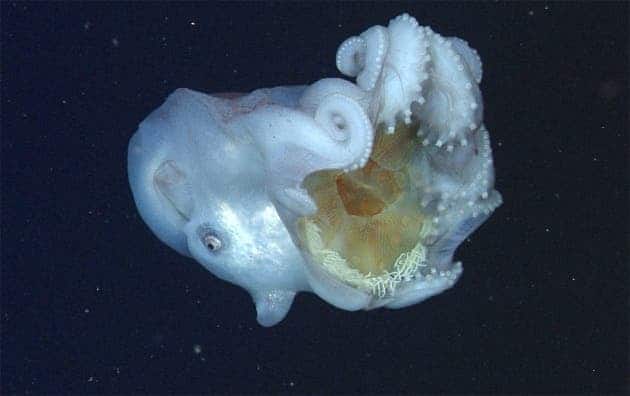The seven-arm octopus (Haliphron atlanticus) is very rarely seen. In fact, the Monterey Bay Aquarium’s submersible has only seen three of them in the past 27 years. Unsurprisingly, little was known about what it eats. Luckily, the footage from the last sighting is extremely sharp and we have a clear view of its last meal. The octopus was eating an egg yolk jellyfish (Phacellophora camtschatica). Jellyfish have very few calories, but the seven-arm octopus uses so little energy that jellyfish seem to be enough for it.
A clear view of the seven-armed octopus holding on to an egg yolk jellyfish. Image credits: Monterey Bay Aquarium Research Institute.
First, let’s talk a bit about the seven-arm octopus. It actually does have eight arms, but one is tucked in a sack under its eye and only used for transferring sperm. When it’s time to mate, it releases the tentacle and attaches it to the female. The seven-arm octopus is also one of the largest invertebrates in the ocean. The females can grow up to 4 meters long and weight 75 kg. These octopuses are important parts of the food chain and are eaten by sperm whales, blue sharks, and some open ocean fish.
Re-opening the files
Scientists from the Monterey Bay Aquarium Research Institute (MBARI) compiled all their live sightings and known specimens. From re-watching the tapes, they observed that all three of the octopuses were carrying something gelatinous. However, the first two instances, it was hard to see exactly what this object was. For example, the octopus in the second sighting was carrying a yellow mass, but it could have been eggs or a jellyfish. In the most recent sighting, it is extremely clear that the octopus is holding on to an egg yolk jellyfish.
The second sighting of the seven-arm octopus holding something yellow and jelly-like. Video credits: Our Oceans.
Next, they examined a few preserved specimens that were caught in the 1970s and 1990s, each of them had the remains of jellyfish or salps in its stomach. Two trawl-captured specimens contained what was possibly coronate medusae. The five in the Hamburg Zoological Museum all contained gelatinous fauna their stomachs.
A tool?
Although the jellyfish appeared to be mostly eaten, the octopus was still holding on to the tentacles with its arms and its beak had pierced through the jellyfish’s bell. The jellyfish might be more than a meal, it could also be a tool. Perhaps the octopus uses it to catch more nutritious prey or for defense.
This discovery doesn’t come as a surprise because all of the other octopuses in the same group also have a tight connection with jellyfish. The juveniles of Ocythoe tuberculata live inside of large salps. Another, Tremoctopus gracilisis, is known to carry the powerful stinging tentacles of the Portuguese man-of-war as defense or to catch prey. The seven-arm octopus is actually the last member of this group to have a confirmed connection to jellyfish.

Low-calorie diet
“It’s an unusual observation, but it’s not as surprising as you might think. The dominant organisms in the deep sea are gelatinous, so it makes sense that other things eat them,” says Mike Vecchione, a marine zoologist with the US National Oceanic and Atmospheric Administration in Washington DC.
Though jellyfish contain a very low-calorie content (they are almost all water), they can provide enough food for large, slow-growing ocean animals. For example, the giant ocean sunfish and sea turtles eat mostly jellyfish. The seven-arm octopus is also among the giants of the sea, but it doesn’t require as much energy as other octopuses. The octopus caught on film had eaten the stomach, oral arms, and gonads of the jellyfish. These are the most nutritional parts of the jellyfish; fish and sea turtles also use the same eating strategy. Although it seems like such large animals would need more energy, they use so little energy that it works for them. Their motto: “live slow, grow big”.
Journal reference: & Sci. Rep. 7, 44952 (2017).






